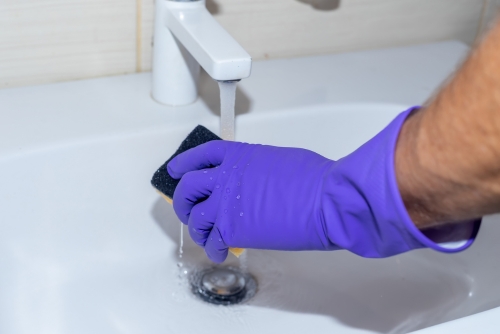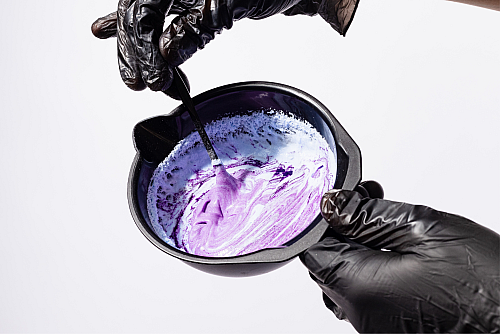
When choosing the right disposable gloves, understanding the differences between nitrile vs vinyl gloves is crucial. Whether you're handling food, cleaning with chemicals, or dyeing hair, the right glove ensures safety and comfort. This guide compares nitrile and vinyl gloves, with insights into latex gloves, to help you make an informed choice.
Why Choose Nitrile vs. Vinyl Gloves?
Nitrile vs vinyl gloves is a common comparison for professionals and individuals seeking durable, cost-effective, and safe options. Nitrile gloves, made from synthetic rubber, offer superior strength and chemical resistance. Vinyl gloves, made from PVC, are more affordable but less durable. Below, we break down their key differences to guide your decision.
Key Features of Nitrile Gloves:

- Superior Durability and Puncture Resistance: Nitrile's inherent strength makes it ideal for tasks with a high risk of punctures or tears. Mechanics, laboratory technicians, and anyone handling sharp objects can benefit from the added protection nitrile gloves provide. Did you know? A study by the American Society for Testing and Materials (ASTM) found that nitrile gloves can withstand up to three times the puncture force compared to vinyl gloves.
- Excellent Chemical Resistance: Nitrile gloves offer superior chemical resistance compared to vinyl gloves. They can effectively shield your hands from exposure to a variety of chemicals, including acids, alcohols, oils, and greases.
- Enhanced Tactile Sensitivity and Dexterity: Despite their strength, nitrile gloves maintain a good degree of tactile sensitivity. This allows for better finger dexterity and control when handling delicate objects or performing intricate tasks.
- Latex- and Powder-Free Options Available: For those with latex allergies, nitrile gloves offer a safe and effective alternative. Additionally, powder-free nitrile gloves minimize the risk of airborne allergens and potential contamination in sensitive environments.
Vinyl Gloves: Affordability and Convenience

When comparing nitrile vs vinyl gloves for cleaning tasks, nitrile gloves are the superior choice—particularly when handling harsh chemicals such as bleach, ammonia, or disinfectants. Nitrile gloves are made from a synthetic rubber that offers high resistance to punctures, abrasions, and chemical exposure, making them ideal for environments where durability and protection are critical.
In contrast, vinyl gloves are made from PVC and tend to be thinner and less resistant to chemical breakdown. With prolonged use, especially in the presence of strong cleaning agents, vinyl gloves can become brittle or even tear, increasing the risk of skin irritation or chemical burns. For safety, comfort, and effective performance during heavy-duty cleaning, nitrile gloves provide better protection and reliability.
Key Features of Vinyl Gloves:
- Cost-Effective and Budget-Friendly: Vinyl gloves are generally less expensive than nitrile gloves, making them a suitable choice for tasks where frequent glove changes are necessary or high durability isn't a primary concern.
- Comfortable and Flexible for Everyday Use: Vinyl gloves offer a comfortable and flexible fit, ideal for short-term wear or tasks that don't involve harsh chemicals.
- Limited Chemical Resistance: While vinyl gloves offer some protection against mild chemicals, they are not recommended for handling strong chemicals or hazardous materials.
Nitrile vs. Vinyl Gloves: Key Differences

Here’s how nitrile vs vinyl gloves compare across critical factors:
- Durability: Nitrile gloves are puncture-resistant and ideal for demanding tasks. Vinyl gloves are less durable, suitable for low-risk activities.
- Chemical Resistance: Nitrile excels in handling chemicals like bleach, making it perfect for cleaning. Vinyl offers limited resistance and may degrade with harsh substances.
- Cost: Vinyl gloves are cheaper, ideal for budget-conscious users. Nitrile gloves cost more but offer better protection.
- Allergy Safety: Nitrile is hypoallergenic, reducing risks for users with latex allergies. Vinyl is also latex-free but less comfortable for sensitive skin like eczema.
- Comfort and Fit: Nitrile gloves conform to the hand for a snug fit. Vinyl gloves are looser, which may affect dexterity.
Nitrile vs. Vinyl Gloves: Right Disposable Gloves
Choosing between nitrile and vinyl gloves boils down to understanding the specific needs of your task. Here are some key factors to consider.
What is the risk level of the task?

- High-Risk vs. Low-Risk Environments: For high-risk situations involving bodily fluids, hazardous chemicals, or sharp objects, nitrile gloves are the clear winner due to their superior puncture resistance and chemical protection. In low-risk environments like food handling or light cleaning, vinyl gloves may suffice.
- Durability Needs (Extended Wear vs. Short-Term Use): For extended wear or tasks with a high risk of punctures or tears, nitrile gloves offer superior durability. Vinyl gloves might be suitable for short-term use or frequent glove changes.
- Chemical Exposure Potential: If you are handling harsh chemicals, oils, or greases, nitrile gloves are essential for their superior chemical resistance. Vinyl gloves offer minimal protection against such hazards.
- Tactile Sensitivity Requirements (Dexterity vs. Basic Protection): For tasks requiring good finger dexterity and control, nitrile gloves provide a better balance between protection and tactile sensitivity. Vinyl gloves, while comfortable, may limit dexterity slightly.
- Do you have a Latex Allergy? Nitrile gloves are an excellent alternative for those with latex allergies.
- Cost Considerations: Vinyl gloves are generally more affordable, making them a good choice for low-risk tasks or situations where frequent glove changes are required. Nitrile gloves offer a higher level of protection but come at a slightly higher cost.
When to Choose Nitrile Gloves:
- High-risk situations and bodily fluids (medical professions, tattooing)
- Working with harsh chemicals and oils (mechanics, industrial cleaning)
- Extended wear needs and durability (laboratory work, automotive repairs)
- Tasks requiring good tactile sensitivity and dexterity (electronics assembly, jewelry making)
- Latex allergies

When to Choose Vinyl Gloves:
- Low-risk tasks and food handling (grocery stores, food preparation)
- Short-term use and frequent glove changes (painting, hairdressing)
- Budget-conscious needs (non-critical tasks, occasional use)
Latex vs. Nitrile vs. Vinyl Gloves: A Comprehensive Comparison
For those exploring latex vs nitrile vs vinyl gloves, here's a detailed comparison:
| Feature | Nitrile Gloves | Vinyl Gloves | Latex Gloves |
|---|---|---|---|
| Material | Synthetic rubber | Polyvinyl chloride (PVC) | Natural rubber |
| Durability | High (puncture-resistant) | Moderate (prone to tearing) | High (elastic but less than nitrile) |
| Chemical Resistance | Excellent (e.g., bleach, oils) | Limited (not for harsh chemicals) | Moderate (not ideal for oils) |
| Allergy Safety | Hypoallergenic | Hypoallergenic | Risk of latex allergies |
| Cost | Moderate to high | Low | Moderate |
| Best For | Medical, cleaning, hair dye | Food prep, low-risk tasks | Medical, general use (if no allergies) |
Latex vs nitrile vs vinyl gloves is a key consideration for users needing versatility. Nitrile is often the top choice for its balance of durability and allergy safety, while vinyl suits budget-friendly, low-risk tasks. Latex is effective but risky for allergy-prone users.
Nitrile vs. Vinyl Gloves for Specific Uses
Nitrile vs. Vinyl Gloves for Cleaning

For nitrile vs vinyl gloves for cleaning, nitrile is the better choice, especially with harsh chemicals like bleach. Vinyl gloves may degrade with prolonged chemical exposure, making them less safe.
- Nitrile: Ideal for handling raw meat or oily foods due to puncture resistance.
- Vinyl: Suitable for low-risk tasks like assembling sandwiches.
- Tip: Check Health Canada standards for food-safe gloves in Canada.
Nitrile vs. Vinyl Gloves for Food Handling

When choosing nitrile vs vinyl gloves for food or food prep, both are FDA-approved for food safety, but nitrile is preferred for its durability and resistance to punctures. Vinyl gloves are cost-effective for short-term, low-risk food handling, like serving or light prep.
- Nitrile: Use for tasks involving bleach, detergents, or solvents (e.g., "Can you use nitrile gloves with bleach?" Yes, they’re highly resistant).
- Vinyl: Best for light cleaning with mild soaps.
- Tip: Ensure proper glove thickness (e.g., 4–5 mil for nitrile) for chemical safety.
Nitrile vs. Vinyl Gloves for Hair Dye

When dyeing hair, nitrile vs vinyl gloves for hair dye is critical. Nitrile gloves are recommended for their chemical resistance, preventing dye stains and skin irritation. Vinyl gloves may tear or allow dye seepage.
- Nitrile: Protects against hair dye chemicals and is hypoallergenic for sensitive skin.
- Vinyl: Less effective, may tear during prolonged use.
- Tip: Choose nitrile gloves for eczema-prone skin to avoid irritation.
Making an Informed Choice
While this guide focused on Nitrile and Vinyl gloves, there's a wider world of hand protection options to explore. If you're looking for medical exam gloves for a doctor's appointment or at-home medical needs, nitrile or latex gloves are common choices. For household cleaning, disposable vinyl or nitrile gloves offer a good balance of protection and affordability. Home Depot and other hardware stores often carry a variety of gloves, including chemical-resistant gloves for tougher tasks.

If you're a professional needing PPE (Personal Protective Equipment), explore options beyond gloves, like safety glasses and respirators. For browsing online retailers like Winsham Fabrik, Staples, consider searching by material (nitrile, latex), mil thickness, or brand names like Framar. Remember, gift cards can be a great way to save on these purchases!
By understanding the key differences between nitrile and vinyl gloves, you can make an informed decision about which option best suits your needs. Remember, the best gloves prioritize both safety and comfort. For high-risk environments, extensive chemical exposure, or tasks requiring dexterity, nitrile gloves offer superior protection. For low-risk tasks or situations where frequent glove changes are necessary, vinyl gloves may be a suitable and cost-effective alternative.
Tips for Choosing the Right Gloves:
- Consider the size: Gloves should fit snugly but allow for some movement. Avoid overly loose or tight-fitting gloves.
- Think about comfort: Opt for gloves made from breathable materials, especially for extended wear.
- Read the labels: Pay attention to the glove's intended use, material composition, and any relevant certifications.
- Don't hesitate to consult a professional: If you're unsure about which gloves are right for your specific needs, consult a safety expert or healthcare professional for guidance.
By following these tips and utilizing the information provided, you can confidently choose the perfect pair of nitrile or vinyl gloves for any task, ensuring optimal hand protection and safety.ami
Additional Considerations for Healthcare
- Sterile vs. Non-Sterile Gloves: Sterile gloves are essential in medical settings where maintaining a sterile environment is crucial. Both nitrile and vinyl gloves can be available in sterile options.
- Glove Liners: For added comfort and protection under nitrile gloves, consider using glove liners. These thin, often cotton or synthetic liners help absorb sweat and reduce the risk of skin irritation during extended wear.
- Glove Powder: While some vinyl gloves come powdered for easier donning, powdered gloves can be a source of airborne allergens and may not be suitable for all environments. Powder-free options are generally preferred.
- Ambidextrous vs. Handed Gloves: Ambidextrous gloves can be worn on either hand, offering convenience and cost savings. However, handed gloves provide a better fit and may enhance dexterity.
- Cuff Styles: Nitrile and vinyl gloves come in various cuff styles, including beaded cuffs for added strength and tear resistance and rolled cuffs for a more comfortable fit.
FAQs About Nitrile vs. Vinyl Gloves
What is the difference between nitrile and vinyl gloves?
Nitrile gloves are made from synthetic rubber, offering high durability and chemical resistance. Vinyl gloves, made from PVC, are cheaper but less durable and suitable for low-risk tasks.
Are nitrile or vinyl gloves better for food prep?
Nitrile gloves are better for food prep due to their puncture resistance, especially for handling oily or raw foods. Vinyl gloves work for low-risk tasks but are less durable.
Can you use nitrile gloves for cleaning with bleach?
Yes, nitrile gloves are excellent for cleaning with bleach due to their strong chemical resistance, unlike vinyl gloves, which may degrade.
Are nitrile or vinyl gloves better for hair dye?
Nitrile gloves are better for hair dyeing, offering chemical resistance and hypoallergenic properties, reducing risks for sensitive skin or eczema.
Which gloves are best for allergies?
Nitrile gloves are hypoallergenic and ideal for users with latex allergies or sensitive skin conditions like eczema. Vinyl gloves are also latex-free but less comfortable.
Stay Safe, Stay Protected: Find the Perfect Gloves for You!
Choosing between nitrile vs vinyl gloves depends on your needs. Nitrile gloves excel in durability, chemical resistance, and allergy safety, making them ideal for medical, cleaning, and hair dye tasks. Vinyl gloves are cost-effective for low-risk activities like food prep. For a broader comparison, latex vs nitrile vs vinyl gloves shows nitrile as the versatile choice for most users.
Now that you're armed with the knowledge to differentiate between nitrile gloves and vinyl gloves, browse our extensive selection to find the perfect pair for your needs! We offer a variety of sizes, thicknesses, and features to ensure optimal hand protection in any situation.
Shop Nitrile Gloves Now!
Shop Vinyl Gloves Now!
Have lingering questions? Our friendly customer service team is happy to help! Contact us today or visit our Help Center for additional information.

